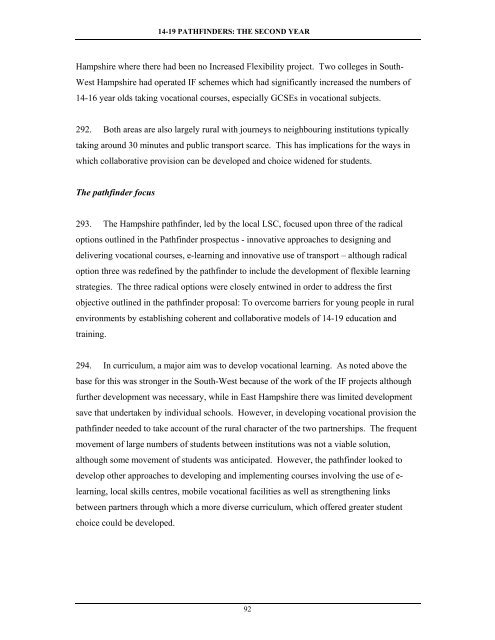Collaborative Approaches to 14-19 Provision - Communities and ...
Collaborative Approaches to 14-19 Provision - Communities and ...
Collaborative Approaches to 14-19 Provision - Communities and ...
- No tags were found...
Create successful ePaper yourself
Turn your PDF publications into a flip-book with our unique Google optimized e-Paper software.
<strong>14</strong>-<strong>19</strong> PATHFINDERS: THE SECOND YEARHampshire where there had been no Increased Flexibility project. Two colleges in South-West Hampshire had operated IF schemes which had significantly increased the numbers of<strong>14</strong>-16 year olds taking vocational courses, especially GCSEs in vocational subjects.292. Both areas are also largely rural with journeys <strong>to</strong> neighbouring institutions typicallytaking around 30 minutes <strong>and</strong> public transport scarce. This has implications for the ways inwhich collaborative provision can be developed <strong>and</strong> choice widened for students.The pathfinder focus293. The Hampshire pathfinder, led by the local LSC, focused upon three of the radicaloptions outlined in the Pathfinder prospectus - innovative approaches <strong>to</strong> designing <strong>and</strong>delivering vocational courses, e-learning <strong>and</strong> innovative use of transport – although radicaloption three was redefined by the pathfinder <strong>to</strong> include the development of flexible learningstrategies. The three radical options were closely entwined in order <strong>to</strong> address the firs<strong>to</strong>bjective outlined in the pathfinder proposal: To overcome barriers for young people in ruralenvironments by establishing coherent <strong>and</strong> collaborative models of <strong>14</strong>-<strong>19</strong> education <strong>and</strong>training.294. In curriculum, a major aim was <strong>to</strong> develop vocational learning. As noted above thebase for this was stronger in the South-West because of the work of the IF projects althoughfurther development was necessary, while in East Hampshire there was limited developmentsave that undertaken by individual schools. However, in developing vocational provision thepathfinder needed <strong>to</strong> take account of the rural character of the two partnerships. The frequentmovement of large numbers of students between institutions was not a viable solution,although some movement of students was anticipated. However, the pathfinder looked <strong>to</strong>develop other approaches <strong>to</strong> developing <strong>and</strong> implementing courses involving the use of e-learning, local skills centres, mobile vocational facilities as well as strengthening linksbetween partners through which a more diverse curriculum, which offered greater studentchoice could be developed.92
















